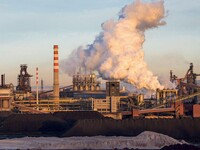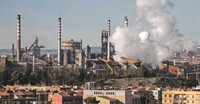Taranto’s Ilva steel factory: the "Zero PAH" coking plant!
July 9th 2014 - Alessandro Marescotti
PeaceLink believes the values of the PAHs detected in the Ilva coking plant still not representative of the actual pollution produced by it.
If an analysis is made of Ilva internal records from the 1st of June to the 7th of July 2014, it can be clearly noticed that the average of 2 nanograms per cubic meter of PAH has been recorded 7 times! (see the attached Excel file).
It is a value that seems unlikely to be. Indeed in 2010, in the Tamburi district the average of PAHs was some 20 nanograms per cubic meter: how is it that today such a low value is marked within the coke plant?
Obtaining such result means that for a good part of the day the instrumentation must be measuring "zero PAH." To check whether these values are reliable, we went to the Itria Valley to monitor air quality: the best results we've seen in the historic center of Locorotondo. Indeed in this area, under optimal conditions, PAHs decreased to levels so low as to record an average of 3 nanograms per cubic meter (2.6 ng/m3 for accuracy equivalent to 3 ng/m3 with rounding used for all other measurements).
The historic center of Locorotondo - one of the most beautiful towns in Italy - has been confirmed as one of the places where the air is cleaner.
The paradoxical conclusion we draw from this comparison between the Ilva coke oven and the historic center of Locorotondo is that some days the air you breathe within the coke oven is even better than the one in Locorotondo!
The average measurement in June and July within the coking plant is - considering the days when peak PAH is monitored - of 12 nanograms per cubic meter, a figure lower than that recorded in the Tamburi district in the same period, i.e. 16 nanograms per cubic meter. How is it possible that the air quality in the coking plant is better than that of the neighborhood of Taranto Tamburi? The figure resulting from monitoring within Ilva is staggering.
Then there is another baffling fact. In the second quarter of 2013 the average PAH value in the Tamburi district was of 36 nanograms per cubic meter. It was a high figure, far higher than the 2009-2010 average one in the same neighborhood that ranged between 19 and 20 nanograms per cubic meter, as reported by A.R.P.A Puglia (Regional Agency for pollution Prevention and Protection) on the 4th of June 2010. We considered that as a provisional figure, influenced by the winter period which is characterized by higher concentrations of PAH. The data recorded during summer time in the Tamburi district (16 nanograms per cubic meter) gives us the possibility to calculate the winter/summer average: 26 nanograms per cubic meter.
It is clear that the data obtained is, however, higher than the average one of 2009-2010. The conclusion is one and only one: today in the Tamburi neighborhood the average figure obtained from the air measurement station officially provided by A.I.A. (Integrated Environmental Authorisation) is higher than that of 2009-2010 coming from the air measurement station placed in Machiavelli Street.
Who talks about big changes in air quality has to deal with these data.
We have divided today’s Tamburi district data into a chart and the result is that the days in which PAHs were in acceptable concentrations (6 to 10 ng/m3) were only 9%. The days with poor air (PAH values between 11 and 15 ng/m3) are 36%. The days with bad air are 55% (PAH between 16 and 20 ng/m3). The days with good air (under 6 ng/m3) are 0% (there is none!). While in the coke oven, good air days in the same period are 47%!
We had already noted with dismay the issue in the past with this press release of January 2nd 2014
http://www.peacelink.it/ecologia/docs/4602.pdf
In it, we highlighted that the Ilva coking plant featured average concentrations of PAHs that ranged between 27 and 31 ng/m3, lower than the values recorded in the corresponding period in the above mentioned district. A.R.P.A Puglia had promised to remove the system of "protection" and "wetness" around the coke plant’s air measurement station. But months later the result is that the PAHs in the plant have even dropped to levels lower than those occurring in the city: 12 ng/m3.
This official A.I.A. monitoring system is so bewildering that no comments are needed: just the evidence.
Who will bear the responsibility to define these results reliable?
Allegati
Excel Chart
Alessandro Marescotti19 Kb - Formato xlsxLicenza: Pubblico Dominio
Articoli correlati
 Anche tu puoi contribuire con una donazione
Anche tu puoi contribuire con una donazioneCosa PeaceLink ha fatto nel 2025, dalla A alla Z
Una comunità di volontari per la pace, i diritti e l’ambiente ha messo in campo una vasta serie di iniziative per promuovere il cambiamento e la giustizia sociale tramite la comunicazione, la controinformazione e la cittadinanza attiva.16 dicembre 2025 - Redazione PeaceLink Agenzia stampa AdnKronos
Agenzia stampa AdnKronosEx Ilva: Peacelink a Senato, 'azienda morta non è strategica'
12 dicembre 2025 Comunicato stampa dell'Associazione PeaceLink
Comunicato stampa dell'Associazione PeaceLinkDDL 1731 - Continuità operativa stabilimenti ex-ILVA
La Nona Commissione del Senato ha ufficialmente richiesto a PeaceLink un contributo scritto in merito al nuovo provvedimento salva-ILVA.12 dicembre 2025 - Associazione PeaceLink Grazie al sostegno dei cittadini
Grazie al sostegno dei cittadiniSette associazioni hanno impugnato l’Autorizzazione Integrata Ambientale (AIA) dell'ex ILVA
L'AIA è stata impugnata davanti al Tribunale Amministrativo Regionale di Lecce. Nel dettaglio, l’AIA è stata impugnata con riferimento a sei profili di illegittimità. Per la prima volta è stata eccepita anche la questione di legittimità costituzionale dei “decreti salva Ilva”.23 ottobre 2025 - Redazione


Sociale.network